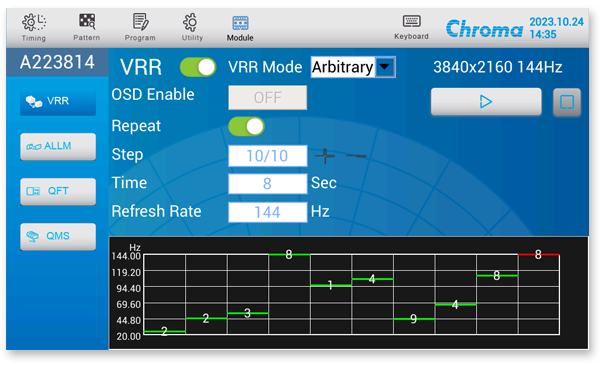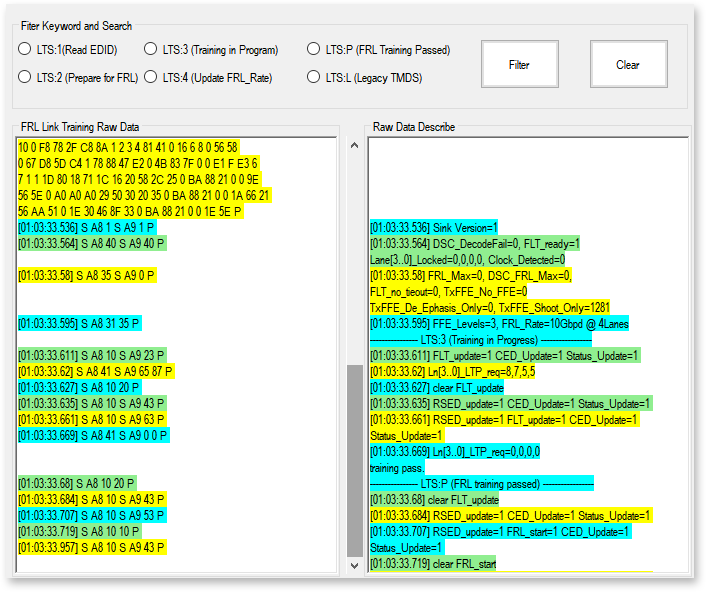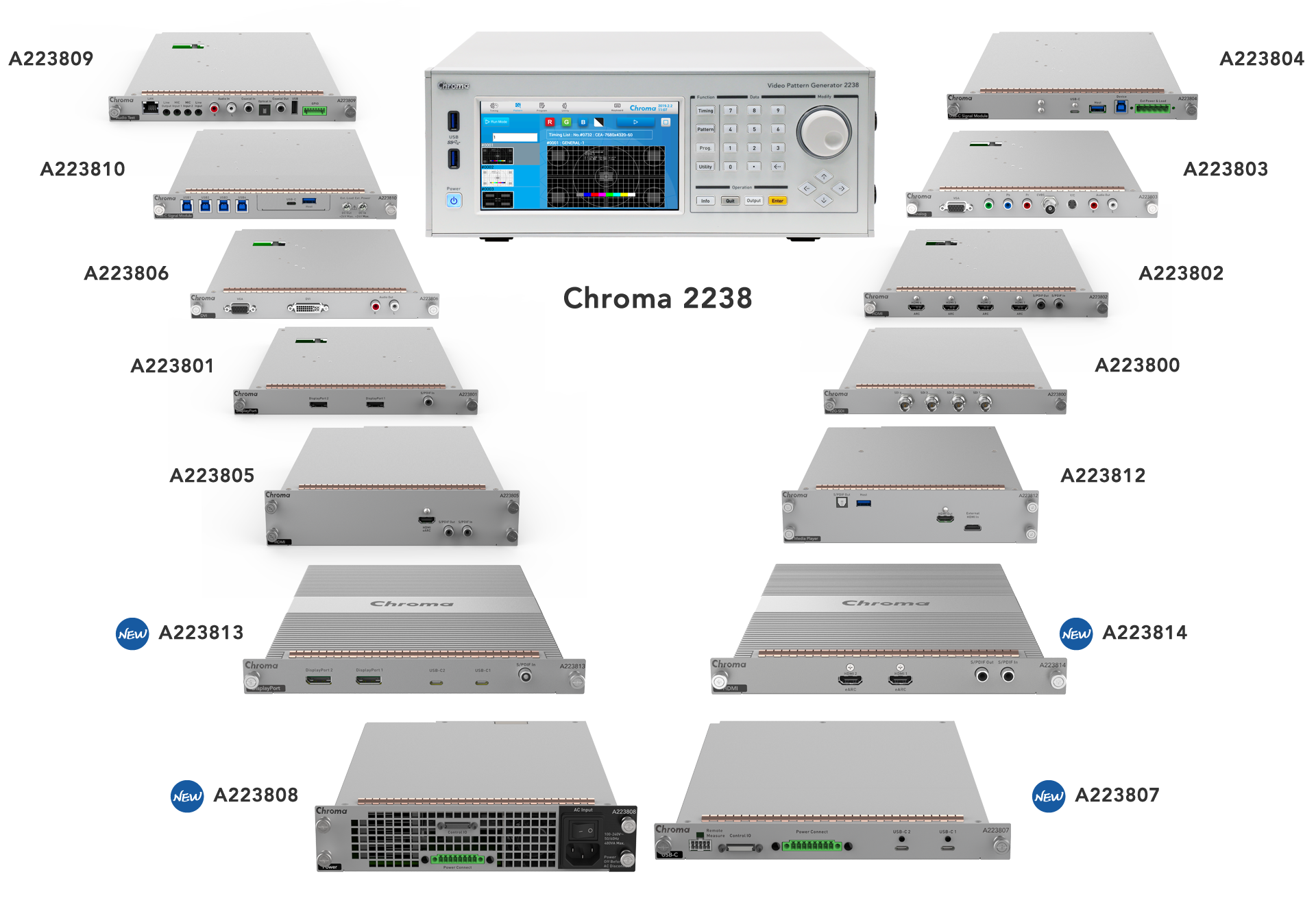
The following contents are the preliminary specifications of the product, and are subject to change without prior notice.
A223814 comes with 2 HDMI outputs, both of which can simultaneously deliver HDMI 2.1b with lane rates up to 48 Gbps. The module supports image output up to 10K@120Hz and 2K@540Hz, and features CTA-861-I, Optimized Video Timing (OVT), and VESA standard timings. Users can freely edit horizontal and vertical timing parameters with support for various high-end frame rates (e.g., 144Hz, 165Hz, 240Hz, 480Hz, 540Hz) for gaming, movie, medical and other applications.
*VESA stands for Video Electronics Standards Association.
*OVT functionality is supported in firmware versions 3.03 and later.

*Actual application depends on the specific use case.
The technology of VRR (Variable Refresh Rate) or Gaming-VRR can apply to many areas and one of them is to meet the rapid change of gaming images. The frame rate of gaming images usually changes at any moment, and Gaming-VRR can reduce or eliminate the phenomenon of video lag, jitter, choppiness, and screen tearing. The A223814 can set the range of frame rate (VRRMIN and VRRMAX) to alter in time making the image refresh rate smoother when changing continuously. It is suitable for various screen applications allowing you to experience gaming more effortlessly.

A223814 is equipped with four VRR testing modes: Saw, Ramp, Square, and Arbitrary. These modes allow users to adjust refresh rates anywhere between 20Hz and 560Hz, enabling them to simulate a wide range of refresh rates that displays may encounter during gaming. In Arbitrary mode, users can freely set the parameters for frame rate and duration to observe variations in the tested image and its quality.

▲ Saw

▲ Ramp

▲ Square

▲ Arbitrary
QMS (Quick Media Switching), or QMS-VRR, addresses potential screen blackouts and judder during rapid changes in refresh rate (e.g., when dynamically switching between 60fps and 24fps images). A223814 can automatically detect changes in output frequency ranges, or allow users to manually set parameters such as QMS-TFRMIN, QMS-TFRMAX, and NEXT_TFR. The QMS-VRR test function, which supports a wide range of frequencies, enables stable image signal output to ensure smooth playback with seamless transitions and no screen blackouts.
*This feature is supported in firmware versions 3.02 and later.
ALLM (Auto Low Latency Mode) enables picture delay by setting the parameters of Gaming-VRR and QMS-VRR to play video smoothly and uninterruptedly. The A223814 allows users to edit the ALLM parameters and select the window (OSD) to display the inspection status so that they can easily understand the screen change process during the test.
The QFT (Quick Frame Transport) function accelerates the transmission speed of each dynamic image frame by adjusting the parameter value of FVA (Fast VActive) to reduce the transmission delay between the signal source and the display, creating a smooth interactive virtual reality game without increasing the frame rate of the signal device.
The FVA function can reduce the time required for picture transmission to gain superior performance, low latency, and power saving. The A223814 allows users to set the FVA inspection parameters for segments 1~16, or apply them to Gaming-VRR to form multiple combinations for testing.
Source-Based Tone Mapping (SBTM) is a feature added in HDMI 2.1a for HDR optimization. It integrates functionality that allows the Sink end to receive various HDR formats transmitted by the Source, automatically optimizing the HDR output. It serves as a supplementary application to current HDR10 and HLG display technologies rather than replacing them. While standard dynamic range (SDR) typically presents content in a single-display mode, the SBTM function enables a multi-window mode that allows simultaneous display of HDR content through different windows. A223814 provides two SBTM_mode options (G-RDM and D-RDM) and allows users to switch between different scene applications by adjusting SBTM_type. For example, users can create composite screens for video and movies, overlay games or PC desktop screens, and display video or movie content simultaneously.
*This feature is supported in firmware versions 3.03 and later.

▲ HDR / SDR

▲ SBTM
Dolby Vision is an HDR format that supports Rec.2020 color gamut and a 12-bit color depth to display more than 68 billion colors while the HDR10 supports a 10-bit color depth to display 1 billion colors. The A223814 has built-in test patterns of Dolby Vision to rapidly verify the functions on the DUT by providing color detection maps that conform to today's image output for brightness, contrast, color, sharpness, etc.(*Dolby Vision is owned by Dolby®)

Without Dolby Vision

With Dolby Vision
*REF:Dolby HDMI Test Equipment Version 1.2.1
Besides the HDR (High Dynamic Range) image output, the A223814 is able to output the test items of HDR10+, HLG, and HDR10 functions, targeting the factors that affect the visual perception of consumers. Users can freely adjust the HDR Metadata to test the HDR-related functions. Various standard patterns such as grayscale, color bars, window shapes, etc. are embedded for HDR bidirectional testing as desired.
* HDR10+ functionality is supported in firmware versions 3.02 and later.
*A223814 Color Space List
A223814 supports multiple color space outputs, including various wide color gamuts, in addition to the basic color space. Supported color spaces include RGB, ITU-601, ITU-709, xvYCC-601, xvYCC-709, sYCC-601, opYCC-601, opRGB, BT2020YC(NCL), ST2113 DCI RGB, BT2020 RGB, and BT2020cYCC(CL). Pixel encoding formats YCbCr 4:4:4, 4:2:2, and 4:2:0, and color depths of 24, 30, and 36 bits can all be set up for an even wider color spectrum, achieving truly natural colors and high-resolution image display.
*BT2020 cYCC functionality is supported in firmware versions 3.03 and later.
FRL (Fixed Rate Link) exceeds the TMDS image transmission mode previously used in HDMI1.4/2.0 in a more efficient manner. In FRL mode, the Data Rate can select 3, 6, 8, 10, or 12 Gbps according to the resolutions and set the number of Lanes (3, 4 Lane).
 FRL Link Training Raw Data → Raw Data Describe
FRL Link Training Raw Data → Raw Data Describe
The FRL Link Training supported by the A223814 has Raw Data transformation function so that users can quickly understand the data contents of each execution program in FRL Link Training. Using VPG Master Software on a PC, users can view the transformed content of LTS1 ~ 4 and LTS L by section via the Filter Keyword and Search function, which is convenient for the system administrator to perform debugging and analysis.
The A223814 also equips an FRL Link Training status monitoring function (VPG Master Software). In a complex training process, the detailed FRL Link Training execution program path and the final training results (FRL, TMDS) are displayed in a diagram, simplifying the complexity to facilitate the administrator identifying the transmission rate supported by the DUT.
*This feature is supported in firmware versions 3.02.

FEC (Forward Error Correction) is a technique to control transmission errors in a one-way communication system. It reduces the bit error rate by sending additional information along with the data for error recovery. The A223814 packet transmission supports FEC, which can avoid data loss and damage during transmission, and can automatically correct and recover data.

HDCP (High-Bandwidth Digital Content Protection) is a protection technology to ensure that digital images and sounds are not copied during transmission. The A223814 supports the up-to-date HDCP 2.3, 2.2, and 1.4 versions that can be switched for use as required. During the tests, the results of the related tests will be directly displayed on the output screen for users to intuitively view and judge the HDCP handshake results.
During testing, A223814 allows both HDMI ports to simultaneously show the relevant test results on the screen of the display under test. It features two modes: PATTERN Mode and LINK CODE Mode. In PATTERN Mode, HDCP is automatically executed, and the results are displayed on the screen. LINK CODE Mode executes the HDCP process step by step. In the event of a failure in the handshake process, users can intuitively identify issues and potential causes.
EDID (Extended Display Identification Data) is a standard established by VESA for DDC (Display Data Channel) identification. A223814 uses I2C to directly read, compare, and write to the display's internal EDID register. This register contains manufacturer information, product serial number, production date, resolution, color settings, frequency range limitations, and more. Both HDMI ports can be individually controlled by an external PC through the software interface, allowing users to edit EDID files, control various functions, and display comprehensive analysis results.

HF-EEODB (HDMI Forum EDID Extension Override Data Block) is an addition to the EDID structure introduced by the HDMI Forum in its HDMI 2.1a specifications. It is primarily designed to save space by improving on the Block Map specified by VESA. A223814 offers three options: automatic identification, user-enforced Block Map, and HF-EEODB. These choices enable reading, comparing, and writing to the display's internal EDID register, allowing users the freedom to edit and operate as needed.
*This feature is supported in firmware versions 3.03
The A223814 acting as an eARC Receiver can display the eARC status, quickly detect the training process, and confirm the related eARC functional tests on the DUT. As a transmitter, it can transfer the lossless and uncompressed LPCM, which has 8 independent audio test signal generators (FL, FR, RL, RR, FC, LFE, RLC, RRC) embedded inside. Respective tests can be performed by enabling or disabling the sound volume, tone, audio, sample rate, sample bit, sweep, etc., providing up to 48 kinds of test combinations.
DSC (Display Stream Compression) is a function developed by Video Electronics Standards Association (VESA) and adopted in the HDMI 2.1 standard by the HDMI Licensing Administrator, Inc. The A223814 supports VESA DSC 1.2a with a maximum compression ratio of 4.5:1. Through the DSC function, users can transmit a larger amount of data under the same bandwidth. When the DSC function is not turned on and set up as 4:4:4 Pixel encoding format, the HDMI 2.1 standard supports a maximum resolution of 10K@30Hz for image output; the resolution is up to 10K@120Hz, 4:2:2 or 4:2:0 Pixel encoding format when the DSC function is turned on.

The VPG Master software has a DSC conversion function to compress images into DSC format. In addition to the 37 built-in image files, it also supports loading external test image files (bmp, jpg, tiff) up to 100 images for storage, users can customize the image resolution, refresh rate, color space, horizontal or vertical cutting, and compression ratio, etc. Moreover, a text string (up to 31 characters) can be entered with customized font, size, color, and coordinates to print on the image file, and download directly to Chroma 2238 so that users can identify if the DSC is enabled or disabled.
When conducting a quality comparison test between two display panels, it's essential to have identical signals from the same source for a fair test. This is why A223814 features two HDMI 2.1b output ports supported by its Dual Output mode, suitable for dual-display applications as well as testing a single display with two inputs.
To avoid confusion between output ports or cables, users can activate the built-in On-Screen Display (OSD) function. This function displays on-screen information about each output port to help users accurately identify each display under test. Users can customize their OSD preferences, such as position, size, and color settings, to easily distinguish between the two display screens.

In Dual Output mode, A223814 combines and displays the results of EDID or HDCP handshakes and analyses directly on the screen of the display under test.

The built-in FPGA (Field Programmable Gate Array) equipped with an ultra-high-speed graphics engine can rapidly process a large amount of image data and greatly improve the graphics and data transmission speed. The switching time of ultra-high-resolution images requires only 0.2 seconds (8K as an example), which enhances the inspection efficiency. In the meantime, technical support for new functions, debugging, and software upgrades are provided for a comprehensive after-sales service.
The A223814 is a reliable and impartial signal module that delivers best-in-class image quality inspections and stringent signal integrity tests.
Chroma 2238 Video Pattern Generator integrates complete executable programs with timings, test patterns, and audio that can be configured freely according to testing needs. Not only does the equipment carry up to 2000 timing patterns and 5000 images, users also can add their own test patterns to meet a large variety of test specifications.
The built-in resolution test chart can accurately indicate the correct scale according to different Timings. In addition to geometric shapes and aspect ratio tests (4:3, 16:9), other test patterns such as Color Bar and Grayscale are also included. With these test patterns, users can easily determine the display's imaging quality and simultaneously monitor the HDCP and EDID execution status on the on-screen display, especially useful for R&D, production and QA purposes.
High conductivity beryllium copper improves the conductivity between components and reduces electromagnetic radiation leakage interfering with the DUT, in compliance with CE/EMC (Electromagnetic Compatibility) standards.
Licensed by The Institute of Image Information and Television Engineers in Japan, a variety of 8K Ultra-High Definition wide color gamut test charts are available. (optional)
Chroma 2238 Video Pattern Generator applies to imaging devices, including TV, business/gaming monitor, home/theater projector, VR/AR, medical equipment, aviation/aerospace dashboard, signage, and automotive applications.
 TV
TV Business/
Business/
Gaming Monitor Home/Theater
Home/Theater
Projector VR/AR
VR/AR
 Medical Equipment
Medical Equipment Aviation/
Aviation/
Aerospace Signage
Signage Automotive
Automotive
Video Pattern Generator 2238
HDMI Module Specification Table
| Model |
A223802 |
A223805 |
A223812 |
A223814 |
| HDMI |
HDMI 2.0b |
HDMI 2.1 |
HDMI 2.1 |
HDMI 2.1b |
| Port(s) |
4 |
1 |
1 |
2 |
Resolution
(Max) |
4K@60Hz
8K@60Hz (4 ports) |
8K@60Hz |
8K@60Hz |
10K@120Hz |
| FRL |
- |
48G |
48G |
48G |
| HDCP |
v2.2 / v1.4 |
v2.3 / v2.2 / v1.4 |
v2.3 / v2.2 / v1.4 |
v2.3 / v2.2 / v1.4 |
| Color Depth |
24/30/36 bits |
24/30/36 bits |
24/30/36 bits |
24/30/36 bits |
| Color Space |
- RGB
- ITU-601
- ITU-709
- xvYCC-601
- xvYCC-709
- sYCC-601
- Adobe YCC-601
- Adobe RGB
- BT2020 YCC
- DCI-P3 RGB
- BT2020 RGB
|
- RGB
- ITU-601
- ITU-709
- BT2020 YCC
|
- RGB
- ITU-601
- ITU-709
- BT2020 YCC
|
- RGB
- ITU-601
- ITU-709
- xvYCC-601
- xvYCC-709
- sYCC-601
- opYCC-601 (Adobe YCC-601)
- opRGB (Adobe RGB)
- BT2020 YCC
- ST2113 P3D65 RGB (DCI-P3)
- BT2020 RGB
- BT2020 cYCC
|
| DSC |
- |
● |
● |
● |
| HDR |
HLG / HDR 10 |
HLG / HDR 10 |
- |
HLG / HDR 10 / HDR10+ |
| Dolby |
- |
- |
- |
Dolby Vision |
| VRR |
- |
- |
- |
● |
| FVA |
- |
- |
- |
● |
| ALLM |
- |
- |
- |
● |
| QMS |
- |
- |
- |
● |
| HEVC H.265 |
- |
- |
● |
- |
| ARC |
● |
● |
- |
● |
| eARC |
- |
● |
- |
● |
Full Line of Chroma 2238 Signal Modules
